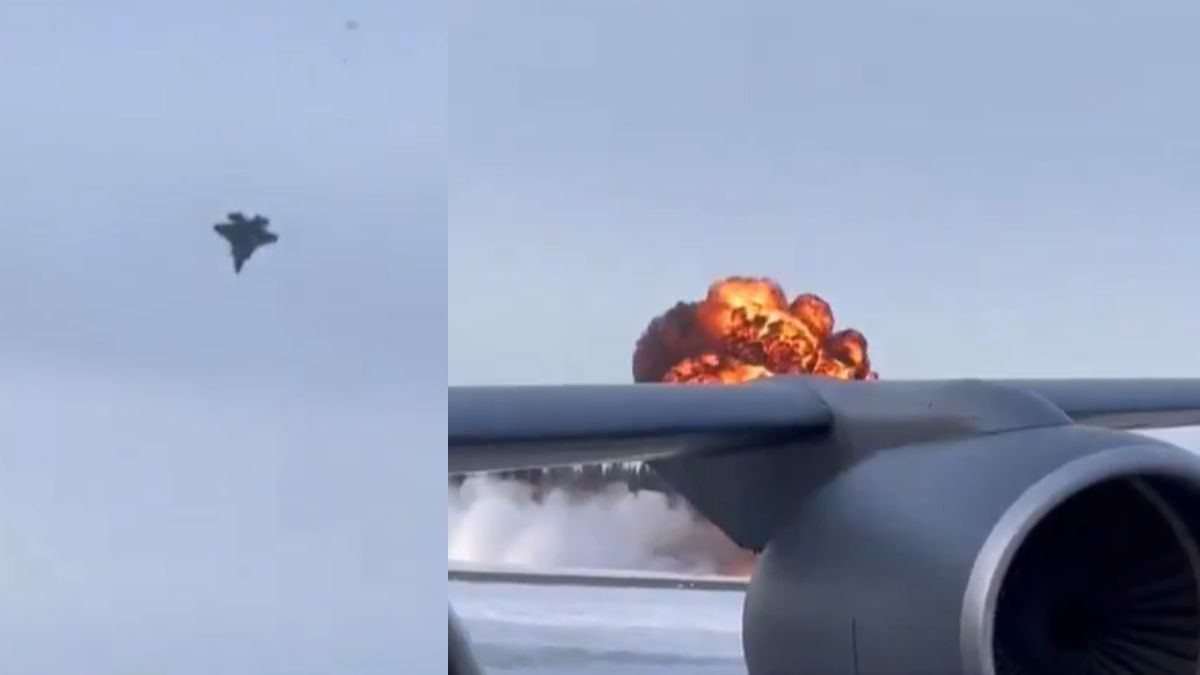F-35 Crash In Alaska: Pilot’s 50-Min Call With Lockheed Engineers, Yet Jet Crashed; What Went Wrong?

While the pilot landed safely, the fighter plane burst into flames, the reason being ice formation in the hydraulic lines (Image courtesy: X.com/BNONews)
A shocking incident caught widespread attention earlier this year when a F-35 fighter jet crashed In Alaska. The crash happened after the pilot engaged in a 50-minute call with Lockheed Martin engineers to solve a problem with his jet, before managing to safely eject, as the plane plunged to the ground.
A video shared online showed the jet spinning towards the runway earlier this year and then catching fire. The pilot was later seen landing safely with a parachute. Now, an accident report released this week has revealed the causes behind the F-35 freefall in Alaska.
F-35 crash in Alaska: What led to the crash?
Around seven months ago, a pilot from the US Air Force had to eject from an F-35 fighter jet he was flying, after spending nearly 50 minutes on a conference call with engineers at Lockheed Martin. He was trying to fix a serious fault before the aircraft crashed on a runway in Alaska.
While the pilot landed safely, the fighter plane burst into flames, the reason being ice formation in the hydraulic lines of the nose and main landing gears. According to a CNN report, the ice in the hydraulic lines of the nose and landing gears stopped the landing gear from working properly and led to the crash.
After takeoff, the pilot tried to pull up the landing gear but could not. When he lowered it again, the nose gear got stuck at an angle to the left. While trying to solve the problem, the jet behaved as if it was already on the ground. The pilot then joined a call with five engineers from Lockheed Martin. They spent almost an hour trying to fix the issue.
Aircraft flying as though on ground?
Recently released accident report has suggested that the F-35’s sensors wrongly showed that it was on the ground. This made the jet impossible to control and the pilot had to eject. The pilot tried two short landings to straighten the stuck nose gear, but both attempts failed. This caused the landing gear to freeze completely.
What happened to the engine?
An inspection by the Air Force found that about one-third of the hydraulic fluid in the nose and right main landing gears were filled with water. Nine days later, a similar problem caused by ice in the hydraulics happened at the same base, but that jet landed without incident. The crash took place in very cold weather, around minus 18 degrees Celsius.
The pilot tried two quick landings to fix the nose gear, but both times it failed, and the main landing gear got stuck as well. After that, the F-35’s sensors acted as if the jet was on the ground, which meant the pilot could no longer control it and had to eject.
The report said that the crew’s decisions during the flight, including the conference call, and weak control over the handling of hazardous materials, played a part in the crash.
What are the criticisms associated with F-35?
Lockheed Martin’s F-35 programme has been criticised for cutting corners during production and for its high costs. The price of the jet fell from about $135.8 million in 2021 to $81 million in 2024, based on a draft agreement with the US Department of Defence. The F-35 programme is expected to run until the year 2088.
The total cost is likely to go beyond $2 trillion, according to the US Government Accountability Office.
Lockheed Martin’s next-generation stealth fighter jet F-35 has been in service for over a decade since 2015. The fighter plane is known for its cutting-edge stealth capabilities and intelligence-gathering features. Despite this, F-35 has faced staunch scrutiny for its high operating costs and persistent technical issues.







